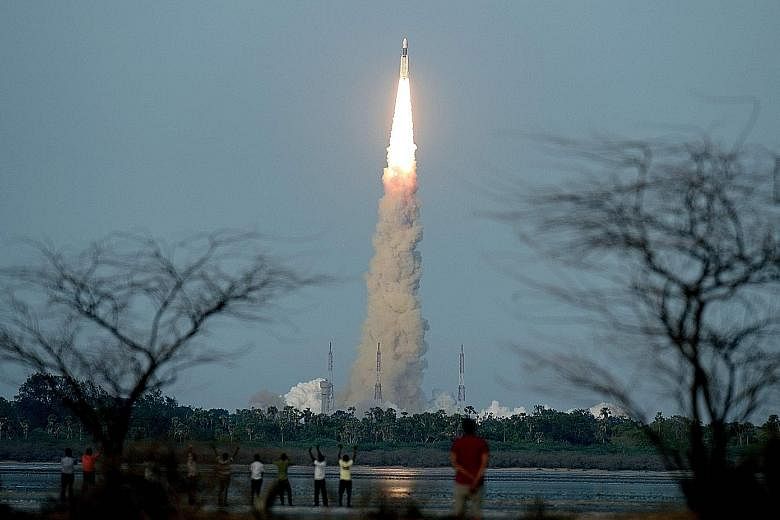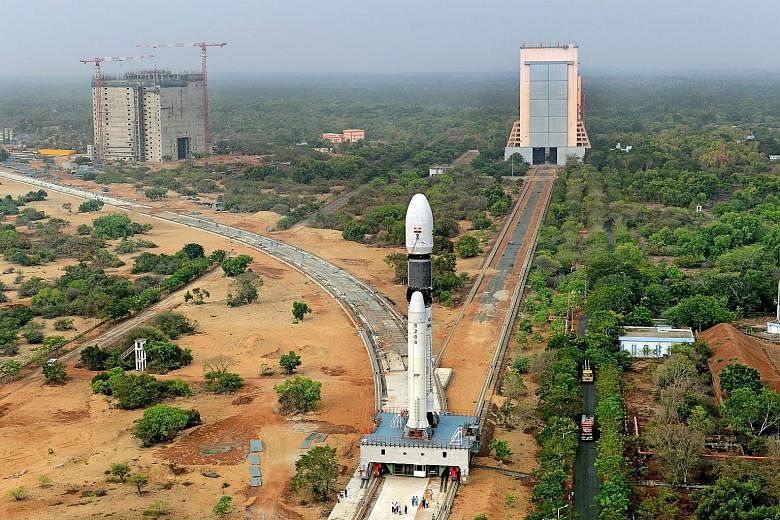India has successfully launched its heaviest rocket, as well as a communication satellite weighing over 3,136kg - the heaviest satellite launched from Indian soil.
The 640-tonne rocket - formally known as Geosynchronous Satellite Launch Vehicle (GSLV) Mark-III - blasted off from the space centre at Sriharikota in the southern state of Andhra Pradesh at 5.28pm Indian time (7.58pm in Singapore) yesterday.
The Indian Space Research Organisation (ISRO) has now proven its ability to launch satellites weighing more than two tonnes and up to four tonnes.
"ISRO has made golden history. We have doubled our capabilities and we have made this a Make-in-India campaign,'' said Mr G. Ayyappan, the mission director for the launch of the GSLV, nicknamed "Fat Boy".
Congratulations poured in from across the country, with Prime Minister Narendra Modi tweeting: "The GSLV MKIII takes India closer to the next-generation launch vehicle and satellite capability. The nation is proud!''
India has enjoyed a largely successful run with its space programme, launching 46 of its own and 180 foreign satellites, including Singapore's first locally-built satellite in 2011.
-
India's space milestones
-
• November 2013: India successfully launches the Mars Orbiter Mission, becoming the first nation in Asia to reach the Red Planet.
• September 2015: A mini variant of the Hubble space telescope called Astrosat, a space observatory weighing 1,513kg, is launched, making India part of an elite club whose members include Japan, Russia, the United States and the European Union.
• December 2015: Six Singapore satellites - a primary satellite called TeLEOS-1, two micro-satellites and three nano-satellites - are sent into space successfully.
• April 28, 2016: Seventh satellite sent into space as part of the Indian Regional Navigation Satellite System, which gives the country its own satellite navigation system.
• June 2016: Launch of 20 satellites at one shot - a record for the Indian Space Research Organisation.
• February 2017: Sets world record by launching 104 satellites, including 88 for a US imaging company, at one go.
• May 2017: Launches the South Asia Satellite, a communication satellite that will help in Internet services and disaster management. Prime Minister Narendra Modi calls the satellite a gift to South Asia.
Nirmala Ganapathy
Yet the programme, which has come to be known for its cost effectiveness after it sent a mission to Mars at a fraction of the cost of a similar US mission in 2013, has been hemmed in by its inability to send up anything heavier than two tonnes.
Space experts said yesterday's launch was a breakthrough for India, which aims to become only the fourth nation in the world - after the United States, Russia and China - to send a manned mission into space.
"GSLV is the largest vehicle and the most powerful one that ISRO has so far developed,'' said Dr K. Kasturirangan, a former ISRO chairman involved in the inception of the rocket a decade ago.
"It is a major landmark that ISRO has achieved, putting us in a league with the US, China and Europe in terms of launching heavier-class satellites. At the same time, when India decides to send a human into space, this will be the rocket that will be used.''
India's space programme has progressed by leaps and bounds, from improving satellite communication navigation systems and remote sensing applications like weather forecasting to space exploration.
In 2013, India launched a successful Mars mission. It also has plans to launch missions to Venus.

Experts said the successfully launched Made-in-India rocket would allow the country to expand its presence in the multibillion-dollar space market.
The latest model comes with a powerful engine developed in India. It is hoped that the technology will help India reduce its reliance on European engines that had propelled some of its spacecraft previously.
"India's space programme was doing pretty well but it had major limitations. India on its own was not able to launch heavy satellites.
"The dependence on other powers will come to an end. India was spending a good amount of money hiring services for heavy satellites. At least it will make those savings,'' said Professor Ajay Lele, a senior fellow at the Delhi-based Institute for Defence Studies and Analyses.
"The other aspect is that futuristic India can now look at growing market for launching heavier satellites."
Scientists in India said they would now work on launching eight-tonne satellites.


